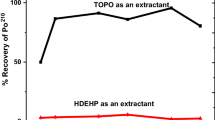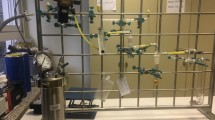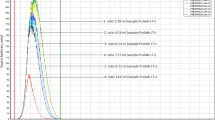Abstract
Nanoparticles containing scintillants were prepared from oil-in-water microemulsions in which styrene-divinylbenzene comprised the oil phase. Primary and secondary fluors [2,5-diphenyloxazole and 1,4-bis(2-methylstyryl) benzene] were dissolved in the oil phase, which was emulsified with dodecyl trimethylammonium bromide or sodium dodecyl sulfate before polymerization by the addition of sodium persulfate. The resulting suspension qualified as non-hazardous waste by testing against US EPA standards for reactivity, pH, ignitability, and toxicity characteristic leaching.14C-glycerol was added to the aqueous nanoparticle suspension and to a conventional organic scintillation cocktail, and the relative efficiency of detection was obtained by liquid scintillation counting. The results were compared with a mathematical model that predicted the effect of particle size and concentration on the probability of an emitted β− particle interacting with a suspended particle. The use of these nanoparticle suspensions represents an opportunity to reduce mixed low-level radioactive hazardous waste generated by liquid scintillation counting.
Similar content being viewed by others
References
Kessler, M.J. (1989)Liquid Scintillation Analysis, Science and Technology, Packard Instrument Co.
Steinberg, D. (1958) Radioassay of carbon-14 in aqueous solutions using a liquid scintillation spectrometer.Nature 182, 740–741.
Myers, L.S. and Brush, A.H. (1962) Counting of alpha and beta radiation in aqueous solutions by the detergent-anthracene scintillation method.Anal. Chem. 34, 342–345.
Harrah, L.A. and Powell, R.C. (1971) Dose rate saturation in plastic scintillators. InOrganic Scintillators and Liquid Scintillation Counting (Horrocks D.L. and Peng C.T., eds), pp 265–278, Academic Press.
Schram, E. (1970) Flow-monitoring of aqueous solutions containing weak b-emitters. In TheCurrent Status of Liquid Scintillation Counting (Bransome, E.D., ed.), pp 95–109, Grune & Stratton.
Ewer, M.J.C. and Harding, N.G.L. (1974) Micellar scintillators: a rational approach to the design of stable assay solvents for liquid scintillation counting. InLiquid Scintillation Counting (vol. 3) (Crook, M.A. and Johnson, P., eds), pp 220–233, Heyden & Son.
Oyewumi, M.O.et al. (2004) Comparison of cell uptake, biodistribution and tumor retention of folate-coated and PEG-coated gadolinium nanoparticles in tumor-bearing mice.J. Cont. Rel. 95, 613–626.
Weekley, J.C.et al. (2004) Aqueous liquid scintillation counting with fluor-containing nanosuspensions.Appl. Rad. Isotop. 60, 887–891.
Wakabayashi, G.et al. (2003) Evaluation of the self-absorption of14C beta-rays in gel-suspension samples by Monte Carlo simulation.J. Radioanalyt. Nuc. Chem. 255, 585–590.
IUPAC (1997)IUPAC Compendium of Chemical Terminology (2nd edn), IUPAC.
Leroy, C. and Rancoita, P.G., eds (2004)Principles of Radiation Interaction in Matter and Detection, World Scientific Publish Co.
Dingfelder, M.et al. (1998) Electron inelastic-scattering cross sections in liquid water.Rad. Phys. Chem. 53, 1–18.
Westbrook, J.A.et al. (2001) Microemulsion polymerization: an undergraduate experiment in the synthesis of nanosized polystyrene particles.Chem. Educator 6, 104–108.
Wang, L.M.et al. (1998) Synthesis and evaluation of a surface-active photoinitiator for microemulsion polymerization.Macromolecules 31, 3446–3453.
Guo, J.S.et al. (1989) Microemulsion polymerization of styrene.Polym. Sci. A 27, 691–710.
Landfester, K.et al. (1999) Formulation and stability mechanisms of polymerizable miniemulsions.Macromolecules 32, 5222–5228.
Author information
Authors and Affiliations
Corresponding author
Rights and permissions
About this article
Cite this article
Zhu, D., Mu, Z., Mooty, C. et al. Suspensions of fluor-containing nanoparticles for quantifying β−-emitting radionuclides in non-hazardous media. J Pharm Innov 1, 76–82 (2006). https://doi.org/10.1007/BF02784883
Issue Date:
DOI: https://doi.org/10.1007/BF02784883




